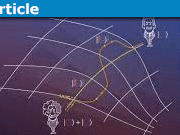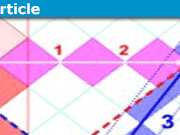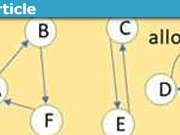The Revival of Newton-Cartan Theory in General Relativity
It’s a calculation that you can find in any textbook on General Relativity (GR): when gravity is weak and does not vary with time, and when particles are traveling slowly concerning the speed of light, GR becomes good old Newtonian gravity again. However, this is done at the level of equations of motion. Conceptually, one can only wonder what happened in that Newtonian limit to the beautiful geometric picture of gravity as spacetime curvature.
In GR we have the equivalence principle, stating that locally an observer can always erase every appearance of gravity by acceleration. Because of this, the group of inertial observers of special relativity (without gravity) is extended in GR to all observers. Everyone is physically equal, as postmodern thinking confirms. In Newtonian gravity, we also have an equivalence principle, albeit more restrictive. Without gravity, inertial observers are connected by Galilei transformations, including spacetime translations, spatial rotations, and Galilei boosts. But when we switch on Newtonian gravity, these Galilei transformations are extended by arbitrary time-dependent accelerations. Locally, an observer can erase Newtonian gravity via such an acceleration. These Galilei transformations plus time-dependent accelerations are not as general as, well, general coordinate transformations, but it’s an equivalence principle.
These considerations give a hint that Newtonian gravity can also be described as spacetime curvature. That this is indeed possible was already shown by Elie Cartan, a few years after Einstein published his theory of GR. Cartan developed a rewriting of Newtonian gravity which is general-covariant, now known as Newton-Cartan theory (NC). Whereas in Newtonian theory, straight trajectories in flat space become curved under the influence of gravity, in Cartan’s reformulation these trajectories are geodesics in curved Newtonian spacetime. At the level of equations of motion, the two theories are the same. So for example, in NC we will not find the orbit of Mercury precessing. But conceptually, the two theories are very different! NC smells a lot like GR. So what is the big difference between these two?
That big difference is the metrical (and hence, causal) structure. In GR, a flat spacetime is described by the Minkowski metric. This is the metric that is kept invariant under the Poincaré transformations of Special Relativity. It allows us to write down a spacetime interval. So in NC one expects that, when we switch off gravity, we find a metric that is kept invariant under the Galilei transformations. However, a quick calculation shows that such a metric does not exist. There is no single spacetime interval that is the same for all Galilean inertial observers. Instead, one finds two separate intervals, one for space and one for time. The physical reason is the appearance of absolute time in the Newtonian world. Under a Galilei boost, the new spatial coordinate involves time, but not the other way around. This leads to a degenerate metric structure: one metric for space, one metric for time, but no metric for spacetime!
This makes NC geometry a bit more subtle than the geometry we know and love of GR. To define inverse metrics, we need to define projective relations. Another subtlety is that the connection coefficients are not uniquely determined by the metrics anymore. Instead, metric compatibility allows for an extra ambiguity in the guise of a closed two-form. The details don’t matter, but after the exposure of GR, these properties can feel a bit uneasy and ugly.
Nevertheless, despite being ‘less pretty’ than GR, NC is a full-blown general covariant description of Newtonian gravity as spacetime curvature. It is also an interesting theory regarding Einstein’s confusion about the whole notion of general covariance. For some time, Einstein was convinced that general covariance was a defining property of GR, but he was corrected by Eric Kretschmann, who noticed that general covariance is not as much of a unique property as Einstein thought. Cartan confronted Einstein with this fact in the most beautiful way: even Newtonian gravity, the theory that Einstein reshaped, could be written down in a general-covariant and geometric way.
So why should we care about NC? There are several reasons. First of all, it provides us with a fantastic pedagogical tool. It forces us to rethink the notion of general covariance. Also, notions like (local) supersymmetry can be defined in the framework of NC. It also gives us a framework in which we can truly compare Newtonian gravity with GR. Another reason is that NC geometry has become important in the non-relativistic limit of the so-called AdS/CFT correspondence. So in this respect, I would like to end with a call to all those future GR textbook writers: don’t leave out this chance to make your readers think more about the notion of space, time, and relativity. Include a section on Newton-Cartan theory!
Loves physics, philosophy and a lot of other stuff. Studied Theoretical Physics, obtained a PhD in Quantum Gravity and Cosmology research. Currently teaching mathematics at a university.








This Youtube playlist contains videos of lectures I gave in various universities to student members of the SPS, and to researchers who haven't taken General Relativity; it's a mostly-heuristic introduction to the subject which relied to some extent on Newton-Cartan theory and related material in MTW, Synge and others. The lectures are briefly reviewed here (see #10). Here's a guide to the lectures.
Also, I wrote up a brief heuristic introduction to Newton-Cartan theory based on my approach, meant to be suitable even for high-school student who took physics, and certainly for undergraduates.
All of this was my way of making general relativity accessible to those students who studied calculus-based physics, will probably never take GR, want more than is offered in all the purely-qualitative presentations in the many wonderful popular books on the subject, and would love a presentation which leverages what they learned in that calculus-based physics course without requiring them to learn additional difficult math.
The utility of Newton-Cartan theory as an introductory path to GR is discussed in this lengthy preface to my textbook (not yet published) which is available as a pdf file. The textbook and lectures are inter-related.
Note: The playlist above is followed by this one, with some cosmology here. There are more videos which will eventually be added to these playlists
Any comments on this material will be much appreciated, particularly from students who never took GR (or from those few professionals who are savvy in GR but nevertheless both value pedagogy and appreciate heuristic treatments avoiding complicated mathematics) : air1@nyu.edu (Currently associated with BGU rather than NYU.)
please help me on investigation of relationship between sin iagainst sin r
“Thank you!
interesting article!
Some resources:
* Misner, Thorne, Wheeler, “Gravitation”, chapter 12 (treats NC without a metric formulation, but is a nice first exposure)
* [URL]http://arxiv.org/abs/1011.1145[/URL], chapter 3 (my own review of the metric formulation of NC)
* [URL]http://arxiv.org/abs/gr-qc/9610036[/URL] (another review on NC and how it is connected to the Newtonian limit of GR)
* [URL]http://arxiv.org/abs/gr-qc/9604054[/URL] (another review with applications to cosmology)
* [URL]http://ls.poly.edu/~jbain/papers/NewtCartan.pdf[/URL] (different versions of NC geometry are compared)
* [URL]http://journals.aps.org/rmp/abstract/10.1103/RevModPhys.36.938[/URL] (an early review)
Hope this gives some nice introductories :)
edit Added to text
Typo: “Newtion”. (2nd-last paragraph.)
[USER=20128]@haushofer[/USER] thanks for the article! I, for one, would greatly appreciate if you would include any good online resources you have found on the topic.
Thank you for that. Reading about Cartan’s reformulation of Newtonian gravity has been on my to-do list for a long time and I’m glad to have wet my toes a little.
Yes, there is a lot of history which can be added to the development of GR.
About your question: such a derivation is not needed; Newton-Cartan theory is exactly equivalent to ordinary Newtonian gravity at the level of equations of motion. So it should give the same result as given by the paper you’re citing. I’ve never encountered such a derivation in the NC literature, anyway.
The same goes e.g. for the precession movement of Mercury. That’s why the argument sometimes found in the literature, that this precession in GR is due to spacetime curvature, can be a bit misleading. NC describes also gravity as spacetime-curvature, but only in the ‘space-time’ direction, not on spatial hypersurfaces of constant absolute time (i.e. ‘space is flat’).
An interesting historical note is that Newtonian gravity still predicts the deflection of light by stars, except there is a factor-of-two discrepancy between Newtonian gravity and GR’s prediction. Deriving this in terms of Newton’s law of gravity may be problematic; instead it’s done by realizing that Newtonian trajectories are conic sections and that the path of light can be described by a very eccentric hyperbola with v=c. A guy I’m not related to wrote about it in 1920: [URL]http://adsabs.harvard.edu/full/1920JRASC..14..285K[/URL] Do you know if anyone has done this derivation with Newton-Cartan gravity?
Another historical note: as you’ve touched on, Einstein is often credited with rewriting gravity in terms of spacetime curvature rather than a gravitational force. However, at the same time, Gunnar Nordstrom (who gives us half of the Reissner-Nordstrom metric) also wrote out a new theory of gravity in terms of spacetime curvature (in modern notation, it has R proportional to T). However, his theory was wrong and Einstein’s was right.
Thank you!
An interesting historical note is that Newtonian gravity still predicts the deflection of light by stars, except there is a factor-of-two discrepancy between Newtonian gravity and GR's prediction. Deriving this in terms of Newton's law of gravity may be problematic; instead it's done by realizing that Newtonian trajectories are conic sections and that the path of light can be described by a very eccentric hyperbola with v=c. A guy I'm not related to wrote about it in 1920: http://adsabs.harvard.edu/full/1920JRASC..14..285K Do you know if anyone has done this derivation with Newton-Cartan gravity?Another historical note: as you've touched on, Einstein is often credited with rewriting gravity in terms of spacetime curvature rather than a gravitational force. However, at the same time, Gunnar Nordstrom (who gives us half of the Reissner-Nordstrom metric) also wrote out a new theory of gravity in terms of spacetime curvature (in modern notation, it has R proportional to T). However, his theory was wrong and Einstein's was right.